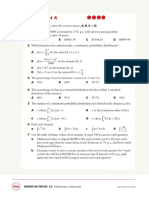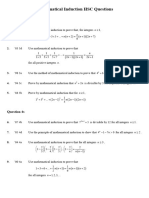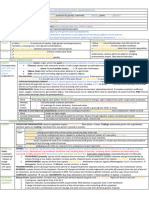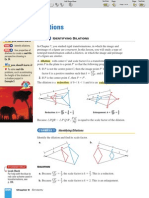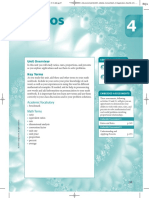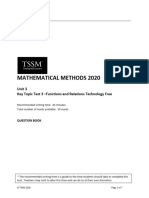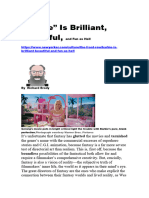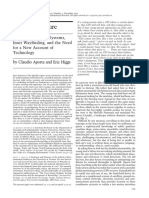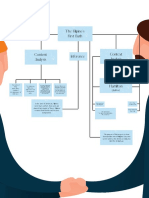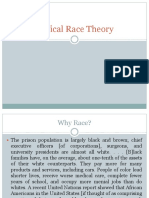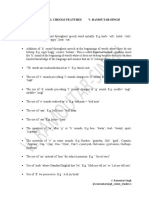CMN 375 Study Guide
Uploaded by
liviakillstein12CMN 375 Study Guide
Uploaded by
liviakillstein12Barbie
Infrastructure:
Two worlds—both are familiar but different
• Barbie world: Multicultural Barbiearchy
• Expands on Barbie Dream House
• A community of Barbies and Kens
• Barbie’s house, view, morning routine, the beach, the party
• Fake food, fake shower
• Travel via car, boat, rocket, bicycle, VW bus
• Narrator: “Barbie has a great day, every day.”
• All female SCOTUS
• Sexism has been solved—though Kens are marginalized
Two worlds—both are familiar but different
• “Real” world: Our world
Structures: Mattel HQs, Gloria’s house, school library, gynecologist’s office
- Streets with cars and construction projects and cat callers
- Sexism pervasive
- Box for Barbie
- Backroom for Ruth Handler
Why Now?
Existential crisis for Gloria who played with Barbies
• Daughter does not respect her
• Works at Mattel
• Has dark thoughts that Barbie empathetically senses
Barbie is an empath
• Disrupts Barbie’s happy life—she starts to think about death
• Bad Barbie advises her to find the source
• Ken hitches along and finds the opposite world—the patriarchy
Multidemsional people and culture
Lots of different Barbies:
• Stereotypical Barbie
• President Barbie
• Supreme Court
• Midge
• Journalist Barbie
• Dr. Barbie
• Lawyer Barbie
• Diplomat Barbie
• And of course.....
• Bad Barbie!
Many Different Kens:
- Kenneth Sean Carson
Real World People:
- Gloria, Sasha, men aat Mattel, police, construction workers, Ruth Handler
Divergent Opinions
- Barbie Verses Ken
- Kens verses the Barbies
- Mother and daughter
- CEO and his crew
Avoid Logical History
It’s Barbie Land—even if we did not play with Barbies (and many of us did!) we enter this imaginary world
Otherworldly yet familiar
• Where the patriarchy has been destroyed/lost
• But we know it has not—this is an illusion and even Barbie cannot be perfect
Place Matters: Barbieland Place Matters: “Real World”
Pink, Pink, Pink, lots of pink! Narrator: “So, Barbie left behind the pastels
• Dream Houses and plastics of Barbie Land for the pastels and
• Dream Cars plastics of Los Angeles.”
• Beach
• Dream Mountains
• Police station
• Dream Palm Trees • School library and lunchroom
• Dream Sun and Moon • Mattel HQs
Explain the Magic:
Child’s Imaginary world brought to life
• Animated dolls
• Have Feelings
• Empathic
• Iconic
• Goes the the gynecologist!
Imagination is magic!
Membrane between the two worlds that dolls and people can move through
• Skipper penetrated it 10 years ago
• Panic at Mattel
• Need to put Barbie back in her box
• (Yes, this symbolizes the patriarchy)
The Fourth Wall
A convention in which an invisible, imaginary wall separates actors from the audience. While the audience
can see through this “wall,” the actors act as if they cannot.
• Before Gloria’s monologue, Barbie breaks though the Fourth Wall with Helen Mirren saying:
• “Note to the filmmakers: Margot Robbie is the wrong person to cast if you want to make this
point.” (That Barbie is not pretty anymore)
Barbenheimer:
• Both Barbie & Oppenheimer (Christopher Nolan) were scheduled for release on July 21, 2023.
• The stark contrast between Barbie, a colorful, whimsical take on the famous doll, and Oppenheimer, a dark
historical drama about the atomic bomb—created a buzz online.
• Which to watch first?
• Memes
• The Barbenheimer buzz contributed to a wider conversation about cinema in 2023, demonstrating that two
very different films could coexist and thrive.
Culture
- Gender swap from real world of the patriarchy which traps men, women, and non-binary people
• Gender binary reified because children know which toys are meant for them
• However, in its effort to be inclusive and representative of real people’s experiences, “the film does well
by trans people in some regards, especially by casting the trans performer Hari Nef as Doctor Barbie and
giving her plenty to do.” (James)
Is to be viewed as a domain of struggle where the production and transmission of knowledge is
always a contested process.
• “Where there is power there is resistance” (Foucault)
• Barbie:
“A contested space”
• “Charting larger movements in the culture”
• Impossible beauty standards
• “Everything we were supposed to be and that we didn’t want to be.” (Steinem)
• Narrator: “Because Barbie can be anything, women can be anything.”
Representing Barbie as a Symbol
Barbie has been the subject of intense controversy, seen both as a symbol of female empowerment and as
an impossible standard of beauty and femininity.
Barbie’s evolution traces Second Wave Feminism
• 1959: Offer image
• 1970s: Demand image
"The only feasible approach seemed a parody.” (Gerwig)
Feminist Barbie
Gerwig understands both the love and the loathing for Barbie, but for many others, the doll remains
an either/or proposition:
Arguments that she is feminist:
• Independent of Ken
• Has owned her dream house since 1962 when women were routinely denied mortgages and
credit cards
• She went to the moon years before Neil Armstrong
• She has been president
Anti-feminist Barbie
• Slumber Party Barbie came with a scale locked at 110 pounds and a “How to Lose Weight” manual, with
the directions “Don’t Eat.”
• Todd Haynes’s breakout short Superstar: The Karen Carpenter Story which used dolls to stage a biopic
about the singer, who died in 1983 of complications from
anorexia.
• Teen Talk Barbie that was programmed to say, “Math class is tough!”
Reasserting the patriarchy
• Narrator: “Well, the Kens have to start somewhere. And one day, the Kens will have as much power and
influence in Barbie Land as women have in the Real World.”
• Ken leads the charge and takes over Barbie Land
• Barbies lulled into the patriarchy as if on a drug
• Serving the Kens, swooning to the Kens, loss of agency and voice
Nothing in Between
Barbie’s decision to become a human suggests the possibility for change even if Barbie Land itself reverts
to its original form
• We can break through life’s restrictions and binaries
• We can embrace life’s chaos and complications
• We can find our true selves in our in-betweens
• The film helps us ask what is it to be human?
• “As Barbie realizes, to be human is to accept that we are all born, and we all die. Hopefully
along the way we find people and things that give our lives meaning, yet that meaning doesn’t
arrive automatically. We must find and embrace it for ourselves.” (James)
1. What are the signs that Barbie is having an existential crisis:
A. She has morning breath.
B. She loses the arches in her feet.
C. She gets cellulite.
D. All of the above
2. According to lecture, Barbie creates a world that reminds of us of childhood. The film achieves this by:
A. Using real sets and a perfect pink.
3. At what point do the lyrics of “Pink” by Lizzo change?
A. After Barbie starts thinking about her mortality at the party.
4. Which film competed with Barbie at the box office but demonstrated that “two very different films could coexist
and thrive”?
C. Oppenheimer
5. According to Tuesday’s lecture, producer Greta Gerwig:
B. Has old photos of herself playing with Barbie.
6. What was the process for creating costumes for Barbie?
A. Aligning the costumes with the vision of Barbie's world.
B. Paying homage to classic, iconic outfits with a contemporary twist.
C. Creating toy-like plastic sheen associated with Barbie.
D. Creating distinct outfits reflecting Barbie and Ken’s personalities.
E. All of the above
7. According to lecture, the “Fourth Wall” is when:
D. The film breaks through the imaginary wall between actors and viewers via narration.
8. Lecture defined Barbie as a contested space. We see this in how she:
A. Charts cultural change over the decades.
B. Is a symbol of empowerment and impossible beauty standards.
9. “Barbie and Ken and Nothing in Between” critiques Barbie for its depiction of gender as:
B. Overly simplistic.
10. Gerwig managed Barbie’s controversial status by presenting the film as a:
C. Parody.
Handmaid’s Tale
Narrative Reiteration
Book: Margaret Atwood, 1985
• Created mirror images of our own world that are
distorted but familiar
• Started writing in East Germany in 1984
• Film (1991)
• Literature of witness: Offred
• Feminist: women’s stories/lives are important
• Without women society cannot continue
• The Testaments (2017)
Departs from the book’s structure while maintaining its message
• Appeals to book readers who know the
story well
• “Salvaging” chapter later in the
book
Provides backstory that book suggests
• The before times
• The failed escape
• The successful coup
Dystopian near-future in which a radical right-wing coup has
transformed U.S. liberal democracy into a literal-minded, theocratic dictatorship
Prediction?
• Anti-prediction: “if the future can be described in detail, maybe it won’t happen. But wishful thinking
cannot be depended upon either.” (Atwood, New York Times 2017)
The Handmaid’s Tale: Dystopian Fiction
Imagined, futuristic bad places
• Dystopian fiction explores the dangerous effects of political and social structures on humanity’s future
Features of dystopias:
• Dark vision of the future
• Communities in decline
• Dehumanizing and frightening
• Characters battle oppression
Feeding the imagination: complex storylines and characters
• Dystopias are places audiences can go and leave
• A Warning
• Activate action
• Circles back to humanism: The idea that most human beings are interested in the ultimate good
A Warning: The Culture Wars
Traditional values verses embracing change
• Access to abortion and contraceptives
• 28 states have abortion bans based on gestational duration
• 13 states total ban (Guttmacher, 2024)
• Traditional marriage verses marriage equality
• Gender roles, transgender and sexual orientation rights, Don’t Say Gay bills (Florida)
• Sen. Blackburn to Ketanji Brown Jackson:
“Can you define a woman?”
World Making: The Handmaid’s Tale
Infrastructure
Gilead closely resembles the world we inhabit now
• Familiar cars (Prius)
• Large homes for commanders
• Servants do most of the
housework
• Converted gyms for training handmaids
• Cell phones: Tinder
• Uber
• Craig’s List
Why Now?
Gilead is established as a nation
• Post “revolution”
• Environmental destruction
• Extreme low fertility rates
• Need fertile women to keep society going Handmaids are the new normal
• “Soon all of this will be normal,” Aunt Lydia Handmaids’ growing resistance
• Ofglen/Emily and Offred/June
Multidimensional Culture and People
Categories of people and social/economic classes
• Handmaids, wives, commanders, Marthas, Drivers, “Eyes”
Divergent Opinions
Lots of suppressed conflict
• Wives and handmaids
• Wives and commanders
• Aunts and handmaids
• Marthas and handmaids
• Ruling class and the masses
Avoiding Logical History
We don’t see the revolution (until later)
• Medias Res (Latin: in the midst of things)
• Gilead erasing history
• Destroying famous churches
• Enter the story with Offred/June’s story
• Terrifying, unimaginable, and yet...
Place Matters
Waterford’s large but cramped house
• Claustrophobic, like a woman’s world in Gilead
• Red Center familiar as a high school gym
• The sounds of the Guardians in the streets
• The sound of the doors opening to the Commander’s office
Explain the “Magic”
All the horrors have either happened in world history or are happening now (Atwood)
• Group executions: salvagings
• Sumptuary laws: dress code/food restrictions
• Book burnings
• Women denied literacy
• Purity tests to lift birth rates: the Nazi/SS
Lebensborn program
• Child-stealing: Argentine generals
• Family separations at our southern border
• The history of slavery
• The history of American polygamy
• The naming of women
Ensuring Support
Started writing in East Germany in 1984
• Not safe to speak
• Bugs everywhere
• Snitches everywhere
Authorities convince subjects that they are acting for the good of society
• “It is fun to participate.”
Patriarchal Subjugation
“Totalitarianism always has views on who should be allowed to have babies
and what should be done with the babies.” (Atwood, Telegraph 2017)
• Commander Waterford: “Better doesn’t mean for everyone.”
• Patriarchy: social system in which men hold primary power and representation in political, economic and
moral spheres
• Denies women equal access/rights/voice
• How does Gilead maintain its power over others?
• Terror
Surveillance State
The Eyes
• “Under his eye”
• Public/private terror
• “Someone’s always watching”
• Churches destroyed
• Kidnapping
Self-surveillance
• “Blessed be the fruit,” / “May it open” greetings
• Handmaids’ partners
Violence and complicity
• Salvagings/Particutions
• Aunts as enforcers/“mimic men” (Bhabha 1994)
Naming
Offred, Ofwarren, Ofglen
• 9th Century England wives took husband’s surname
• Identified as husband’s “property” into the 1960s (Ivy 2010)
• Offred: offered as sacrifice, off-red
• Naming selves in Red Center in book and in show
• Book: “Alma, Janine, Delores, Moira, June.”
• Resistance
• Individual identities maintained
• June=Mayday
Color Schemes
Categorization and de-individualization
• Red for handmaids (“menstruation” Crabtree)
• Blue for wives (Virgin Mary)
• Brown for aunts (enforcers)
• Khaki for Marthas (house servants)
• Stripes for econo-wives
• Black for commanders (“powerful and mystic hue,” Crabtree)
Costumes
Handmaids’ costume
• Blinder bonnets (Amish)
• Can’t be distracted like a horse
• Laceless boots
• Can’t commit suicide with laces
• Formless red dress/capes
• “Walking wombs”
Infantilizing
Handmaids treated as if they cannot make own decisions (because they can’t) as if they were children
Blocking: Offred seated while wife and Martha look down on her
• Aunts train and nurture them like a parent with a dose of terror
Radical Feminist Aesthetic
Reed Morano directed first three episodes
• (Frozen River, Looking, Beyoncé’s Sandcastles)
• Created the look of the show
• Cinema of witness (Offred)
• Showing what the word cannot
• Female gaze: June looking at Nick
• Female glance: “unlike steady, obsessive (male) gaze, the glance is sprawling and
nimble...constantly vigilant” (Peterson 4)
• Flits, moves, jumps, spins, obsessed with detail so “moments of woman’s
world” don’t go “unnoticed.” (Peterson 4)
• Natural light sources and sun rim shots
• Erie yet beautiful
• Extreme, tight close ups
• Experience the terror
• The smallness of this world
• Intimacy and interiority
Interiority
Voice-overs: “A chair, a table, a lamp.”
• “A return to traditional values. Waste not want not. I am not being wasted. Why do I want?”
• Flashbacks
Terror through Image and Sound
Sound: heartbeat scene post ceremony
• Creepy music
• Pop music: the end of second episode Simple Minds “Don’t Forget About Me”— empowering
until
Image: Slow motion, natural light as screen, dream like, shallow focus blur the background and makes
faces prominent
How did this happen? We were asleep at the wheel....even though signs were there—the hospital had no
babies
Anamorphic Format
Cinematic technique of shooting a widescreen picture on standard 35mm film (or digital) with a
non-widescreen native aspect ratio
• Aspect ratio: the ratio of the width to the height of an image or screen
• Standard: 2:37.1
• Anamorphic: 2.40:1 (vertical stretch)
• Also, the projection format in which a distorted image is “stretched” by an anamorphic
projection lens to recreate the original aspect ratio on the viewing screen.
• Distorting faces, blurred backgrounds, soft focus, dark lighting
• Enhances the surrealism of Gilead
The Handmaid’s Tale Failing
World-making in a “Post” Racial World
• Evokes terrifying realities for Black and brown women since US’s founding:
• Slavery, rape, child-stealing
• Yet “post-racial” world with Black and brown people in every sector
• Handmaids, enforcers, commanders
• Book/film: people of color sent to colonies
• Show: are we to expect that the ruling elite accepts racial diversity? (Bastién)
• Hulu’s Diversity Clause
A Return to Tradition
Christo-fascist patriarchy imposed on all
• Elite men, commanders, in total control
• Male enforcers in black and armed
• Women subjugated to lower status
• Women enforcers in brown and blue
• How does the Republic of Gilead sustain this system?
• Terror: “They do that really well, make us distrust each other.”
• Complicity
Complicity
Complicity: association with a wrongful act, with state violence in The Handmaid’s Tale
• “Fundamentalism asks you to endure a thousand separate identities and tells you it is freedom.
They sell it to you by telling you it is feminism or “empowerment” or “choice.” (Jones)
• The ceremony
• Birthings
• Salvagings
Complicity: The Salvaging
A valve for the handmaids’ rage
• Complicity in the system
• Commit violence for the system
June/Offred’s rage from learning about Moira’s death
The Ceremony
Genesis 30: Jacob has two wives, Rachel and Leah. When Rachel cannot bear a child, she orders Jacob to
impregnate her maid, Bilhah.
• “And she said, ‘Behold my maid Bilhah, go in unto her; and she shall bear upon my knees, that I may also
have children by her.” (30:3)
• Devised to gain wives’ adherence to the system
Disturbing, horrific for Offred and Serena
• “Seems more like a business transaction.” (CMN 375 student)
• Dehumanizing
Films the experience through Offred’s
POV:
• Chandelier POV shot
• Offred’s head bobbles
• Her disembodied experience
• Women as objects/body parts
• We see Serena Joy’s discomfort and misery
Indoctrination
Consciousness raising, Gilead-style
Women’s World
Conflict between the women
• Wives resent the handmaids so dehumanize and infantilize them
• Wives know the aunts as enforcers
The Women
Handmaids: “Fallen” woman forced to bear children for the righteous (June/Moira/Janean)
Commanders’ Wives: Serena Joy
• Ironic name
Enforcers: The Aunts
• Aunt Lydia with a cattle prod
Serena Joy
Serena Joy: a Phyllis Schlafly character, an anti-feminist woman, before Gilead, preached women belong in
the home as helpmeets; preacher in book; author in show. Cannot read or write now.
Aunt Lydia
Aunt Lydia: Enforcer, empowered by the state to attack, discipline and train the handmaids
Women’s Worlds
Cannot oppress without giving some freedoms
• Women have own bdomains of action:
• Home, kitchen, gardens, and birthings!
Parallel Women’s Worlds
Birthing scenes: Simulated and real
• Parallel editing, slow motion, filtered, natural light, bird’s eye views, women come together
Parallel Worlds Past and Present
Baby stealing: Parallel editing between taking baby away from Offwarren/Janean and woman stealing baby
from June and Luke
• Terrifying yet expected
Survival
Everyone, handmaids, wives, Marthas, aunts, are thrilled for a healthy birth
• Humankind will survive
• The system is working
Dystopian fiction circles back to humanism:
• The idea that most human beings are interested in the ultimate good
Micro-moments of Resistance
Where there is power there is resistance. (Foucault 1984)
• “This will become ordinary.” (Aunt
Lydia)
• “Alma, Janine, Delores, Moira, June.” / Spitting out the cookie (20 m) / Scrabble (words) /
Seeking information / Telling her story / “I intend to survive.” (Offred/June)
Quiz 8: Handmaid’s Tale
1. According to Peterson in “The Radical Feminist Aesthetic of The Handmaid’s Tale,” the camera offers a female
glance that includes tight close ups and flitting jump cuts in order to:
B. Assure that a woman’s world is does not go unnoticed.
2. According to lecture on Tuesday, we see a cameo of Margaret Atwood in The Handmaid’s Tale.
A. True
3. According to lecture, the handmaids’ bonnets are derived from:
A. Amish women’s headwear.
4. Patriarchy is defined as:
C. A social system in which women do not have equal say as men.
5. According to Bastién, The Handmaid’s Tale fails in its world-making by presenting a world in which:
A. People of many races coexist.
C. Gilead is a post racial society that seems incongruous to its Christo-
fascist orientation.
6. In the second episode of The Handmaid’s Tale, we see Offred resist her circumstances when she:
D. Spits out a cookie while looking in the mirror.
7. The color schemes in The Handmaid’s Tale:
A. Categorize the people, especially the women.
B. Subjugate women to class status.
C. Deny women individual identities.
D. All of the above
8. Handmaids’ names are derived from their commander’s first name, which according to lecture on Tuesday
references:
B. Laws that required women to take on their husband’s surname upon marriage.
9. The Handmaid’s Tale conveys Gilead’s terror via image and:
B. Sound
10. The Handmaid’s Tale does not have magic; instead, it has examples of terror. These examples are based on:
B. Historical examples of terror acted upon women and girls.
C. Current day examples of terror acted upon women and girls.
Black Mirror
Showrunners Charlie Brooker and Annabel Jones
• Star Trek and Twilight Zone fans
British anthology television series (2011- present)
• Netflix 2015
Examines unanticipated societal effects of new technologies
• Future
• Dark and satirical
• Bring out the worst in us
“U.S.S. Callister” Virtual Reality Video Game
Real people experience the horror in their consciousness
“Adventure Movie” (Stephen Pehrssen, cinematographer)
“USS Callister”
Positive reviews
• Praising allusions to Star Trek
• Space Fleet
• 1960s high saturation colors
• Star Trek cinematography
• Homage to other sci-fi stories:
• I Have No Mouth, and I Must Scream (Harlan Ellison)
• 2001: A Space Odyssey
• Blade Runner
• Star Trek
Original Star Trek (1966-1969)
• Created by Gene Roddenberry
• Intended to be a Western/adventure with moral lessons
• Progressive values, including casting
- Trekkies
• Satirical look at uber-fandom of Star Trek
• Robert Daly: Fantasy fandom gone AWOL
• Homage to Breaking Bad and Toxic Masculinity and Revenge Fantasy Genre
Utopia and Dystopia
Utopia – an ideal or perfect society, coined by St. Thomas More
• The Jetsons (Hanna-Barbera)
• Star Trek (Gene Roddenberry)
Dystopia – ‘bad’ place
• Blade Runner/Do Androids Dream of Electric Sheep? – Philip K. Dick
• The Handmaid’s Tale (Margaret Atwood/Bruce Miller)
• The Last of Us (Mazen and Druckmann)
Technological Utopianism
Literary phenomenon in America, 1880-1915
• Edward Bellamy – Looking Backward (1888)
Qualities:
• Provides a sense of direction for a chaotic time, when society is at a turning point
• Technology and science as saviors
• Technology will save us (during Covid lockdowns—then
again...)
• Comforting vision of a future in which humans are freed from our bad qualities
“USS Callister” challenges these expectations
Tech Moguls
We want these gadgets and so we give tech moguls access to our privacy and allow lax regulations
(Prime)
• The people building our future
• James Walton and Robert Daly as Tech Stars
Nightmare version of Silicon Valley
Gaming
• AI
• Office life
• Sociopathy
The Irony of Star Fleet Rules
From Star Trek’s utopian vision of the future
• “Star Trek depicted a utopian future that is non-racial, non-classed, and non-gendered”
Captain Daly:
• “Killing in cold blood is against Star Fleet rules.”
• “Star Fleet never turns its back on those who need help.”
Captain Daly lords over his captives
• Cruel and unforgiving
• The digital clones are more sympathetic and empathic than the humans in the story
• Clone Nanette cries
• Shania saves Nanette
• Monsterfied
• Gillian in marketing
Infrastructure
“Real World” “Infinity”
Office &Apartment • USS Callister ship
• Toxic work environment • “Bubble with asshole god”
• High-tech/neutral hues • Space tech/saturated hues
• “Mancave” with Windows • Secret game program
• Panopticon • Endless bar
• Pizza delivery
Why Now?
The Story Our Time
New employee/member of Star Fleet • The possibilities of AI
• Expert coder • Can AI help or hinder us?
• Rebels • How to control AI?
• Nanette aims to escape the hellscape of Daly • Will AI control us?
has created • What is it to be “human(e)”?
Multidimensional Culture and People
“Real World” “Infinity”
• Office culture Star Fleet world
• Toxic to Daly • Hellscape to captives
• Bob verses Robert or Mr. Daly • Never leave
• Callister owners and employees • Captain Daly
• Coders • Crew from USS Callister
• Receptionist • Villains (Valdack)
• Interns • Monster creatures
• Like Star Trek cast diversity • New verb: to monsterfy
Divergent Opinions
“Real World” “Infinity”
Daly verses Walton Daly verses Walton
• Rivalry • Revenge
• Bullying • Surrender
• Nanette, coder • Nanette savior
• Seems innocent • Crew resists
• Vulnerable to revenge porn • Walton sacrifice
Avoid Logical History
“Real World” “Infinity”
Backstory to the company foundation Walton’s story
• Breaking Bad • Tommy (Dutch angle)
• Naming it Callister • Minor transgressions result in cruel outcomes
• Walton agreed, though didn’t know • Jillian from marketing
what it was • “Poor f*&^ers who stepped out of line”
• Social aggression (Shania)
Place Matters
“Real World” “Infinity”
Cramped in toxic office life • Trapped in a TV show ruled by a sociopath
• Low saturation places • High saturation places
• Dense, dark spaces • Star Trek colors, sets, costumes, music
• Hallway
• Small office
• Elevator
Explain the Magic
Convert another’s DNA into a digital clone that this super fan can rule over
• Infinity Mod, a secret game
• They don’t know what goes on out there
• They don’t know what goes on in here
• Coders can save the world and be rewarded
• What comes around goes around (revenge)
The Look: “Spectacular Cinematic Leap”
4:3 aspect ratio to represent the original Star Trek broadcast
• Detailed wide screen and depth of field
• Contrasting hues for parallel sites
• Shania in “redshirt”
• Stock character who gets killed first
• Dutch angles on the ship
• Aerial shots of space
• Montage
Parallel Characters
Robert Daly and Nanette Cole as parallel characters
Captain Daly = Toxic masculinity
Nanette Cole = Female agency
Robert Daly Nanette Cole
- Expert Coder Expert Coder
- Hero to anti-hero Hero
- Secrecy Secrecy
Robert Daly
White, male, toxic masculinity (Slatt)
• Adherence to traditional male gender roles that mainly limits male emotional expression to anger
and resentment
• Harms men and women
Incel behavior contained in own fantasy world
• Self-identifying “involuntary celibate” online subculture
• Can lead to violent acts against others, especially women
• Inconsequential nerd in the office
• Resentment to revenge in the game
Captain Kirk
Ideal white male masculinity of the 1960s
• Fearless yet measured leader
• A ladies’ man
• “Star Trek depicted a utopian future that is non-racial, non-classed, and non-gendered.” • Star Trek’s
gender relations were sexist, yet sexless
• Women’s costumes
• Love interests
Captain Daly
Overlord of captive clones
• Imposes sexist gender roles
• Expects devotion and kissing from female clones
• Women do not have weapons on the planet
• Disempowering them
Punishes women
• Monsterfying them
• Shania and Jillian in Marketing
• Removes Nanette’s face
• Symbolic of the patriarchy and women’s oppression
Captain Daly v. Lieutenant Cole
Adheres to the innocence of Star Trek
• Denies clones sex organs
• If he can’t have sex, neither can they
This is Nanette’s “red line”
• “Taking away my p%^&y”
• She means it
Lieutenant Cole
Surrenders after face removal but does not give up
• Female agency
• Rallies the escape
• Feigns female supplication to lure Daly
• Uses sexuality to keep him distracted
Uses revenge porn against herself to plot escape
• Her secret
• Perils of new technologies especially for women
• Would you care about your other self?
• Certainly, knows herself
The Ending
Reinforces the parallelisms of Nanette Cole and Robert Daly
• She takes over the ship
• He is trapped in Infinity Mod—meaning forever
• She sought escape- not necessarily revenge
• Female triumph
• Who’s in command now?
• Audience pay off
Cinematography
• Parallel editing between Worm Hole and Daly on his ship
• Escape versus being trapped
• Shaking camera
• Stretched faces
• Swirling camera
• What they feel
• Transformation!
Infinity
Time never ends in the Cloud
• New adventures
• Star Fleet (Star Trek) lives on
• Female hero in control
• Male villain trapped in his own hellscape game
• But...whatever happened to Gillian in Marketing?
Quiz 9 USS Callister
1. According to Tuesday’s lecture, Kristen Dunst has a cameo in USS Callister, in which she:
B. Walks across the workplace floor.
2. According the reading “...The True Villains are Real Tech-Moguls” and lecture,
A. The real threat is not AI but the humans who abuse it.
B. We are all to blame for tech failures.
C. Consumers give tech a free pass.
D. All of the above
C. A good place.
4. USS Callister performs a form of world-making that works with:
A. Parallel worlds.
B. Parallel characters.
C. Contrasting hues.
D. All of the above
5. USS Callister pays homage to Star Trek, and, according to lecture:
A. Breaking Bad.
B. Star Wars.
C. 2001 Space Odyssey.
D. All of the above
6. According the reading “...The True Villains are Real Tech-Moguls” and lecture, USS Callister is about:
A. Gaming.
B. AI.
C. Office life.
D. Sociopathy.
E. All of the above
7. According to lecture, Star Trek is an example of:
A. Utopian vision of the future.
8. Robert Daly is an example of:
B. Super-fandom gone “AWOL”.
9. One irony of the Star Fleet rules is that:
B. Captain Daly is cruel to his captives but refuses to kill in cold blood.
10. One big question USS Callister asks is:
C. What happens when human intelligence (feelings and emotions) exist without a body?
The Last of Us
Genre: Post-apocalyptic, survival drama based on the eponymous action- adventure video game created by Naughty
Dog
- 20 years into a pandemic caused by a mass fungal infection, which causes its hosts to transform into
zombie-like creatures and causes societal collapse
- Season 1: Based on the 2013 game, follows a smuggler tasked with escorting the immune teenager Ellie
across a post-apocalyptic United States.
- Season 2: Expected to partly adapt the 2020 sequel is set five years later and introduces Abby.
- 2023: Praise for the performances, writing, production design, and score
- Several called it the best adaptation of a video game
- 2025: Season 2
The Teaser
Adapted from video game’s title’s macro shots of fungus growing in a frenetic and aggressive way
(Elastic)
● Added more layers and lots of color
● Threatening American western music with timpani and harp
Lots of similarities between fungi and humans as species because we build cities and communication networks
as fungi do in nature
● Interlink with one another, communicate, reproduce, and even experience competition and conflict
● Show how fungi grow, split apart and create patterns
● Moving through and reshaping the landscape -> Map of the United States
Dystopia: A Warning
● 1968 roundtable TV interview on threats of fungal spread if earth’s temperatures were to rise to 94 degrees
○ Fungi could take over our brains to infect all humankind
○ Camera draws in closer and closer
○ Environmental destruction
○ Government/corporate control
○ Technological control
○ Loss of individualism
Survival
- Feeding the imagination: complex storylines and characters
○ Often circle back to humanism: The idea that most human beings are interested in the ultimate
good
○ Dystopias are places audiences can go and leave!
Survival Dramas
● One or more characters strive to physically survive
● Life or death struggles against dangerous circumstances
● Human will to live
● Individual motivations and personal desires
● Balance realism and believability with slow-burning suspense to maintain a sense of urgency
● Their effectiveness lies in creating an atmosphere where every moment poses a passive threat to the
protagonist's existence
● Heroic triumph over obstacles that threaten the social order
● Reaffirm social values such as fair play and respect for merit and cooperation
● The group, isolated and in peril, finds solidarity, functioning as an effective unit
● Women are often decisive in the success or failure of the group
● The Last of Us critiques capitalism and world governments for failing their population
● Environmental decay leading to the cordyceps, the fungi that takes over the planet
Infrastructure 2003
- Familiar Texas
- Suburban Homes
- Heighbors
- Mercy the Dog
- Digital Clocks
- Texas Falls Apart
- Helicopters, fighter jets, military on the ground
- Plane crash
- Complete mayhem on what was supposed to be an ordinary day
- We witness the fall of civilization as we know it in real time with Joel, Sarah, and Tommy
- Boston Bombed Out
- High rises collapsed on one another
- Decimated buildings:
- Hotel waterlogged
- Museum with decayed fungi bodies
- Courtyard
- Backrooms where action takes place—subversion to the police state—the resistance
- Burned out cars, collapsed highways, still military everywhere
- Begins with a boy on foot in young woods (no old growth trees)
Why now?
- E2 Backstory —Jakarta researcher mycologist
- Bomb the cities to save humanity
- Meet Tess, Joel’s partner in survival and resistance
- Joel’s brother Tommy is lost wants to find him—needs battery for his truck
- Marlin assigns mission—take Ellie to a Firefly site
- doesn’t say why
- Ellie has survived a zombie attack
- might provide a cure
Multidimensional cultures and people
- Federal Disaster Response Agency (FEDRA )
- Bribery/cop exchange
- Resistance/Fireflies
- Ordinary quest (Joel) to find his brother
- Ellie replaces Sarah as Joel’s focus to save others
- Begins with tragedy
- Ellie is from the other side, privileged even though she’s an orphan. She escaped from military school
with Riley. Both attacked by zombies, but Ellie did not zombify.
Divergent opinions
- Joel and Marlene/Marlene and Kim/Joel and Ellie/Tess and Robert/Zombies and humankind/FEDRA and
the Fireflies
Avoid logical history
- Aftermath of global climate change
- The earth heats up enlivening the killer fungi as suggested by the 1968 researcher
- Fungi take over host, changes host to zombie but still feeds on the host from within
Place matters
- Journey through devasted cities and places within them like a video game
- We hear the sounds/We see the decay/We feel the wet waters/We fear the zombies/We feel sad for the dead
(neighbors)/We smell the burning the dead
Explain the magic
- Cordyceps: Latin “club headed” Zombies
- Joel: “They were people once”
- Humanity
- Ellie is bitten but not infected
- Possible cure
- Video game to a MAX television series
The Process of Creating the Costumes:
- Collaborative Vision: Summers worked closely with showrunner Craig Mazin, who emphasized the
importance of realistic, relatable, and accessible looks.
He requested that the costumes should reflect a world not just deteriorated but lived-in, avoiding
the "fantastical" appearance common in post-apocalyptic media
Color and Style Palette: A muted, neutral color scheme was chosen to enhance the grim aesthetic of the
world.
Aging and Breakdown Department: Every costume, from outerwear to undergarments, went through a
meticulous aging process.
This included techniques like using boiling water, removing wax from materials, and creating
distressed textures to ensure no item looked new.
- Practical Modifications: Items like belts were replaced with makeshift alternatives, such as shoelaces or
pieces of twine, to reflect scavenging and scarcity.
Multiple Versions of Key Items: Key costumes, like Joel's denim and T-shirt, required duplicates at
various wear stages.
Sourcing and Customization: Costumes were often sourced in new condition, then broken down for the
worn look.
For instance, Joel’s jacket initially posed challenges due to its material, leading Summers’ team
to modify store-bought items, like a Flint and Tinder jacket, which was customized and distressed
Narrative Reiteration
- Based on a 2013 video game’s journey across the nation:
- Cities, fields, old towns, the countryside
- Encounter humanity in its worst and best
- Meet new people creating alternative lives
- Meet a gay couple in E3
- Encounter cannibalism in one settlement
- Dangers everywhere...must overcome - Story is key
Save the Cat
Story A: The external story. The stuff that happens on the surface.
- The journey across the US.
- The obstacles Joel and Ellie encounter in the show and video game
- Zombies, death, destruction, crashes, murders
Story B: The internal story. What the hero needs to learn for transformation.
- What Joel needs to learn to feel human again after losing daughter Sarah
- Ellie goes from being “Cargo” to being like a “Daughter” for Joel to protect
Avoided excessive action and obstacles of the video game (Story A)
- Violence is tolerated in video games
- Less so with TV series
- Mistake to think only such connects gamers to the game (Mazin & Druckmann)
Connect to the characters’ emotional lives (Story B)
Two audiences: gamers and non-gamers
- Show gives characters’ backstories and outbreak’s history
- Game requires players to learn to play the game so little backstory
- Game: Joel finds Ellie
- Show: Gives a story of how they meet
Breaks with video game’s one character’s perspective
- Game: Joel’ (mostly)
- Show: Shared with Ellie and minor characters
Visuals
Camera: Action and action-adventure games use third person perspective from a fixed distance behind and slightly
above the player’s character.
Cinematic language: sweeping camera, sharp cuts, close ups and tight spaces.
Image collage: “The built world is unbuilt and rebuilt.” (Mazin)
Focalization: narrative theory adhering close to a character’s thoughts and feelings
Prosthetics: for the infected and not CGI
Diegetic Sound
Diegetic sounds exaggerated like the game’s
- Creep into rooms and listen for trouble. It's how you survive.
- Buildings’ noises: Doors, drawers, footsteps, creaks, clocks, water
- Destruction: Gun fire, car and plane crashes, helicopters, sirens
- Silences: enhance the suspense in both the game and show
Extra Diegetic Sound
- Extra diegetic sounds exaggerated like the game’s
- Terror sounds like The Handmaid’s Tale
Original score by Gustavo Santaolalla (game)
- “An element of danger and innocence”
- Detuned guitar for deep noise
- Recorded in various rooms, kitchens and bathrooms
Extra Diegetic Sound
- Score by Gustavo Santaolalla and David Fleming (show)
- Action-heavy music for the series but also minimalistic
- The “viewer to feel that they're part of the scene rather than be observing the scene”
- Percussions: rusty barrel or like cracking wood or bowing, rusty metal
- ‘80s music signals trouble and clues
- Depeche Mode’s “Never Let Me Down, Again”
- Upbeat sounds and dark lyrics
- Joel and Ellie will let each other down and lift each other up
The Zombies
Living people who have been taken over by a fungus called Cordyceps
- Imitate each other like schools of fish
- Infection evolves over time
Based on science: what such an infection would do to humans via bites or spores
- Infects the brain, kills memory, only goal to spread the infection
- Hands shake, muscle spasms early stages
- Showrunners changed one thing: mycelium as one mode of contact
Runners
- The first stage of infection, 24–48 hours after infection. Fast and can detect uninfected people
Stalkers
- The second stage of infection, about two weeks. Agile and hide around corners, charge when they get close
Clickers
- A later stage of infection where the infected are blind and use echolocation
Bloaters
- A rare but dangerous stage of infection that occurs several years after infection
Shamblers
- A mutated form of the bloater that occurs when exposed to excess water
Rat King
- A super-organism that is a combination of stalkers, clickers, and a bloater
Back to the B Story
- In both the game and show, Joel loses his humanity and gains it back via the shared caring between he and
Ellie
- Lost humanity when lost his daughter Sarah and then the 20 years that ensued
- Ellie is childlike and brings play back into his life
- He wants to protect her/ She saves his life
- They join forces as a family-like team
The Last of Us is about love
Hard Truths
- A game and show about hard truths
- Governments and institutions can fail us
- We must support one another when they do
The Last of Us Quiz 10 Answers
1. In survival dramas, characters:
A. Face life or death struggles against dangerous circumstances.
B. The group, isolated and in peril, finds solidarity, functioning as an effective unit.
C. Women are often decisive in the success or failure of the group.
D. All of the above
2. The Last of Us critiques capitalism for failing the population by:
D. Ignoring the signs of environmental decay from climate change.
3. What was the item that Sarah got fixed for her dad’s birthday before the outbreak?
C. A watch
4. The Last of Us takes place now (why now) because:
B. Ellie survived a zombie bite and might lead to a cure.
C. Joel is seeking his brother whom he has not heard from in weeks.
5. According to lecture, some of the props in The Last of Us indicate that:
B. Time is the essence of survival.
6. What retail store did Costume Designer Cynthia Summers buy Pedro Pascal’s famous denim shirt according to
Tuesday’s lecture on costumes?
B. Walmart
7. What material did Costume Designer Cynthia Summers utilize in The Last of Us?
C. Denim because it has the longevity to withstand the challenges Joel and Ellie face and is considered
timeless.
8. According to Rebecca Nicholson’s review of The Last of Us, the show has:
A. Horror and heart.
9. The internal (B) story in The Last of Us includes:
A.What the hero needs to learn for transformation.
B. What Joel needs to learn to feel human again after losing daughter Sarah.
C. Ellie going from being “Cargo” to like a “daughter” for Joel to protect.
D. All of the above
10. The visuals in The Last of Us aim to resemble the video game via:
D. All of the above
Black Panther
The Expanded Universe
World-Building and the Expanded Universe:
a. Some facts can be taken for granted
i. Existence of superheroes, preexisting characters, set up from previous films (Captain
America: Civil War)
ii. Wakanda (and Black Panther) were introduced in Civil War, and had major influence
in later films (Infinity War, Endgame)
b. Black Panther was the first black superhero in major American comics
i. Created by Stan Lee (writer, editor) and Jack Kirby (artist)
Infrastructure
Vibranium powers a utopic society
a. Golden City Streetcars
b. Magnetic levitation trains
c. Remote-operation of vehicles, ships
d. High-rise skyscrapers and outdoor urban life
Ryan Coogler used Bay Area Rapid Transit (BART) as an inspiration
Why Now?
Inciting incident: T’Challa, in the wake of his father’s death, assumes the throne.
a. Transfer of power
Broader turning point for Wakanda
a. Relations to the outside world
b. Tension within the country itself
c. Conflict between tradition and innovation
Multidimensional Culture and People
The world of Black Panther is populated by friends and foes with competing ideologies and worldviews
○ Within – Nakia, W’Kabi
○ Outside – Klaue, Erik Stevens (Killmonger)
■ Multidimensional people within Wakanda itself
○ Allied tribes united by the first Black Panther
○ The Jabari mountain tribe, led by M’Baku
■ Different language (Igbo Nigerian language vs Xhosa)
Divergent Opinions
Conflict over the future:
a. Ryan Coogler: Tradition vs Innovation
b. The role of tradition in culture
c. Shuri: “Just because something works does not mean it cannot be improved.”
Conflict over Wakanda’s role in black liberation
• “You know, where I’m from, when black folks started revolutions, they never had the firepower or
resources to fight their oppressors.”
Avoiding Logical History
Wakanda: a hidden world Shangri-La
a. Fictitious valley invented by British author James Hilton
b. Lost Horizon (1933)
c. Utopic, untouched by war or conflict
d. Exoticism, Orientalism (Said)
e. 1973 Film Lost Horizon
i. It’s bad. Like, really bad.
Place Matters
• More than a country, a refuge
• Wakanda as resistor of colonization (avoiding logical history)
• Central theme of the film: Is Wakanda better off isolated?
Explain the “Magic”
Shuri: “There’s vibranium all around us.”
a. Not magic: technology.
Wakanda’s isolation and resources have afforded its people tremendous advancement
What makes a “Fight Scene”?
Good action is about more than cool stunts!
Good action involves:
a. Characterization
b. Plot and pacing
c. Positioning
d. Movement we can follow
”Communicating” Action
Black Panther’s casino fight
a. Movement/Placement/Dynamism/Cuts/Tracking shots
Visual Splendor
“The film is all about contrasts.” - Color symbols for tribes:
Lighting and Color
The Artificial Wakanda: Some of the film’s environments, like Warrior Falls, were constructed from the
ground up.
i. Warrior Falls = A Georgia filming backlot!
ii. Four months to build
a. Lighting and color were precisely controlled
- Makeup: continually adjusted as sun changed to make skin tonesn consistent throughout
Costumes
a. Both Carter and Beachler won Oscars for Black Panther
Intricate costuming
b. Required use of new technologies, such as 3-D printing
Themes
1. Black Panther has a lot of themes– many of them political
a. Tradition vs. innovation
b. Cultural, political, economic tensions
c. The role of leadership
i. (Of the country, AND of the world)
2. Central tension:
a. Erik “Killmonger” Stevens
b. King T’Challa
Wakanda and the World
● What’s the best way to help?
○ Military force
○ Influence
○ Investment
● Wakanda is uniquely situated for any of the above
○ U.N. Scene: “What can a nation of farmers have to offer the rest of the world?”
● Black Panther as a franchise has many ties to social movements and actual places
○ Ethiopia (briefly occupied by Italy in the 30s)
○ The Black Panthers: 1966 (“Black Leopard”)
Colonialism
The world of Black Panther is heavily influenced by colonialism
○ Colonialism: Economic, militaristic, or political dominance of one country (the “colony”) by
another.
● Practiced throughout history
○ As early as Ancient Greece
● Advances in seafaring and transport
○ Resource extraction
■ Spices (pepper)
■ Materials
■ Dyes, fabrics
■ Metals
Late 18th century
Peak of transatlantic slave trade
12-13 million Africans forcibly relocated and sold for profit
The end of slavery did not mean the end of Africa’s exploitation
Industrialization, new demand for metals, supplies
Increased transport capacity
Technological advances decreased cost of colonialism
Wealth gaps (continue today)
Colonialism Today
1. While colonialism as a practice may have declined, impacts can still be felt
a. Wealth (economic arrangements)
b. Capacity
c. Self-governance
d. Diplomacy, trade vs. force
Stevens & T’Challa
1. Conflict over the future:
a. Tradition (T’Challa, at least at the beginning of the film)
b. “Innovation” (Erik “Killmonger” Stevens)
c. Shuri, Nakia
i. Represent a kind of fusion
The Music of Black Panther
Not one, but two soundtracks!
92-piece orchestra
40-person choir
Black Panther: The Album; Lamar and SZA
Orchestral Score: Ludwig Göransson
Musical Fusion
Many different sonic influences
Baaba Maal
Legendary Senegalese musician
Hand drums, percussive variety
Western film scores, other superhero scores
Syncopation
Hip-hop/trap beats
World-Making and Music
Music plays an integral role in world-making
Develops characterization
Fleshes out location (Place Matters)
Establishes mood, tone
Emotional resonance
Black Panther’s soundtrack is a fusion of tradition and innovation
Black Panther Quiz
1. According to lecture, a central question of Black Panther is
D. Is Wakanda better off isolated from the world?
2. According to lecture, Black Panther is an example of world-making’s divergent opinions. We see them in
A. Tradition verses Innovation
B. Shuri: “Just because something works does not mean it cannot be improved.”
C. Conflict over Wakanda’s role in black liberation
D. All of the above
3. According to lecture, the magic in Black Panther is
B. Technology
4. According to lecture, Marvel Cinematic Universe (MCU) films are:
A. Interconnected, yet able to be viewed by themselves
5. Wakanda is an example of a
B. Utopia
C. Refuge
6. Infrastructure in Black Panther includes:
A. Public transportation based on the BART system
7. According to lecture, multidimensional cultures and people are represented in Black Panther through:
B. Distinct colors for each allied tribe of Wakanda
8. Black Panther has two villains. They are:
B. Ulysses Klaue and Erik Killmonger
9. Both Black Panther and the reading from Cobb reference:
A. Slaves that died during their transport in captivity
10. According to Cobb, Wakanda is
A. No less imaginary of a place than “Africa”
EEA
Infrastructure
Familiar with what we would see today
• Computers, calculators
• Security cameras, smartphones
• Cars, laundry mat, elevators
• The inevitability of taxes, the IRS and laundry
Technology: Apha verse
33:40-35:35
• Controls jumps between universes (Verse-jumping)
• Alpha verse connects with a brain helmet
Why now?
• Narratively: Family at breaking point
• Weyman asks for a divorce
• Evelyn’s business is under IRS audit
• Joy is joyless
• Culturally: Plethora of multiverse content
• Increased recognition of Asian Americans in cinema
• Increased hate crimes against Asian Americans
Multidimensional cultures and people
• Gong Gong as a traditional Asian parent
• Evelyn and Waymond are immigrants
• Joy is first generation and lesbian
• Becky as a contrast as the white minority in the film
• Deirdre as the typical American boomer and government worker
Avoid logical history
A universe where we can access the skills we have in other universes
• See into and experience other universes
• Communicating between universes using a Bluetooth headset
Divergent Opinions
• Joy wants to be accepted by her family for who she is
• Evelyn wants to win the approval and love of her father
• Waymond wants to have love and support from his wife
• Difficulty with generational differences
• Struggles between mothers and daughters
• Struggles between daughters and fathers
Place Matters:
- Two Places at Once
Explain the Magic
Every choice you make leads to a diverging universe
• Can be every version of yourself without losing the others
• Jumps can used for good or evil
• Too much of other universes can drive us to madness
• Some people are meant to be in our lives across every universe
Costume Team
• Costume designer: Shirley Kurata
• Asian American designer
• Previous work includes Volkswagen and Billie Eilish
• Known for abundance of patterns and color
• Hair: Anissa Salazar
• Makeup : Michelle Chung
Clothes depicting emotion - Joy vs Jobu
- Depression and Mania
- Influences from Icons like Elvis
Pulling from Asian Stereotypes and Culture
- K-Pop stars of the music genre and Harajuku street style
- Face obscuring visor that is often worn by “an Asian grandma”
- Asian Perfect Daughter
Costume - Deirdre
• IRS employee but colorful
• Mustard turtleneck
• Yellow cardigan
• Gold chains
• Red eyeglasses
• Wrist brace
Costume - Evelyn
Glamour
• Wedding gown
• Voluminous tulle skirt
• Beaded bodice
• Lace sleeve detailing
Costume - Evelyn
Function
• Floral shirt
• Similar to Liberty fabric (1875-
present)
• Red quilted jacket
• Cropped pants
• Bought in Chinatown
• Reminiscent of Daniel Kwan’s own mother
Homage:
- Ratatouille
- Carol
- Space Odyssey 2001
- The Matrix
- Kung Fu
Genre Anarchy (A.O. Scott)
• Bollywood romance
• Sci-fi
• Action
• Family drama
• Domestic drama
• Marital comedy
• Immigrant striving story
• Ballard of mother daughter love
• Absurdist comedy-drama
Bureaucratic trauma
• The IRS
Transformational trauma
• The Metamorphosis by Franz Kafka
• Gregor transforms into a cockroach overnight, reflects on his job as a traveling
salesman, which he sees as full of “temporary and constantly changing human
relationships, which never come from the heart.”
Pairs existentialism, which argues that our purpose and meaning in life is determined by ourselves, not outside
forces, with......everything bagels!
• Universe
• Alphaverse: Waymond
Alpha-
Waymond takes over Waymond’s body
• Tells Evelyn that parallel universes exist because every life choice creates a new alternative universe
Alpha-Joy is Jobu Tupaki
• Experiences all universes at once
• Can verse-jump and manipulate matter at will
• Mind was splintered after Alpha-Evelyn pushed her to verse-jump beyond her endurance
• (Mother daughter drama, yes?)
• Created a black hole-like everything bagel topped with everything, which could destroy the multiverse
Alpha-Evelyn is given verse-jumping technology
• Enables people to access the skills, memories, and bodies of their parallel selves by performing bizarre
actions that are statistically unlikely
• To fight Jobu Tupaki’s minions who converge at the IRS
Hero on a journey from the ordinary world
• Her world fraught with uncertainty
• Alphaverse Evelyn is beyond ordinary
• Gains verse-jump powers to save the multiverse
• Multiverse
• Black holes
Evelyn = Everyone
• Every “man” archetype
• “Everyperson” or the “common person”
• Has free will
• Decisions impact others
• Create new impacts
• New universes
• Life is a universe—our own
The every “man” archetype
• A mundane and unremarkable character as a stand-in for the audience
• Runs a laundry mat
• Doesn’t display outward powers or extraordinary strengths
• Ordinary responses to the IRS, husband, daughter, and father
Humble, compassionate, and kind
• Humble might suffice here until things go crazy
• Through the everyman archetype, the audience inserts their own self image into the story and lives it
alongside the character
• We see ourselves in Evelyn
Many, Many Effects
• Unachieved dreams
• Immigrant aspirations
• Wrong and bad choices
• Father’s judgement
• Disconnect with husband
• Divorce papers
• Discord with daughter
• Estrangement
• Evelyn (we) realizes that seeking out and living in moments of meaning makes life worth living.
Cosmogenesis
The understanding that the universe has been expanding since its beginning 14 billion years ago and has developed
into stars, galaxies, life, and human consciousness.
Reality’s complexity
• Living complexity in a complex and demanding world
• Family reality and complexity
Cosmogenesis for Evelyn
A life is chronological—it moves through time, one year after another.
• Alphaverse Evelyn realizes this is false.
• She has many lives, many choices all with repercussions for herself and her loved ones.
• And we learn no one is alone. We are all implicated in our actions and the actions of others.
Why Now?
• Social media desensitizes people with internet access, life is becoming more absurd and harder to
comprehend
• In the US, depression and anxiety are at an all time high, no one’s ‘happy’ and everyone has an urge to
give into the meaninglessness of things
• Consumerism-there is so much to choose from; material things, social media content, food, this makes
deciding on things harder to achieve
• Makes us question if we are in control of our imagination or if the imagination is in control of us
Divervent Opinions
In the beginning, Evelyn had to choose between doing her taxes or helping her seemingly crazy husband
save the multiverse
• Towards the end, Evelyn had to choose between giving into nothing, or embracing everything
Place Matters- No life verse
Raccacoonie verse
Kitchens are usually stressful environments, metallic objects and noises
We cause misfortunes, we can also cause surprises
Everything Bagel
Everything bagel is simply a bagel with everything on it.
Relatable Content
We can relate to the immigrant family dynamic of its main characters:
• A complete lack of understanding permeates every interaction that Evelyn has with her father,
husband, and daughter
Dysfunctional family
• Mother-daughter relationship
• Generational differences
Regrets
• Paths untaken
Transformation
• Growth
• Communication
Laundry
• Its never ending!
Taxes
• One of life’s great certainties alongside death
Intergenerational Truama
Gong Gong
• Evelyn’s judgmental father
Evelyn
• Difficulty in unlearning and relearning how to love
Joy
• Imploding and explosive behavior
Waymond
• Graceful patience and quiet understanding through it all
Opening Scene
Narratively
Happy family watching a movie
Reality:
Evelyn is very stressed, mundane life and overwhelmed, buried in papers
Waymond wants her attention
• Switching between Mandarin and English—lacking communication
- Evelyn focused on father’s visit and judgement
• Waymond tells her Gong Gong will be impressed
• Evelyn tells Waymond to watch the noodles
Narrative chaos and lack of communication
Opening Scene
Cinematically
Stress Cyclone Reality:
• Art direction: Everything has a purpose
• Round mirror frames happy family switches to reality
• Packed frame (messy, cramped, laundry bags papers everywhere money issues)
• Waymond appears in another round mirror
• Father with baby Joy rack focus:
• Focus switches within the shot to emphasize a new element or for dialogue
Montage
Creating a new composite from fragments of pictures, texts, sounds and music
• Compresses time and place
• Can impart chaos
Topoi
Recurring symbol with meaning such as a flag or religious text
• In Everything Everywhere All at Once topoi: circles!
• Circles represent the cycle of life and more
• An enclosed system that has no edges we just go round and round
• Mirrors, googly eyes, bagels
- Frames action and meaning
• Parallel universes
• This is just one
Trope
A figurative or metaphorical use of word or expression; figure of speech, common or overused theme
or device, image, sound
• Sci-fi trope of the “chosen one” who will save the universe
• Evelyn subverts this trope through her use of “others’ skills” that she taps into through the memories and
skills of her alternative selves:
• Martial arts, cooking abilities, acting, sign flipping...
Subverting “The Chosen One” Trope
Her victory of saving her daughter and uniting her family comes from embracing others.
• Evelyn, “the chosen none,” ultimately didn't win the day. Evelyn the mother did
Emotional Pay-off
- The existence of a multiverse turns Evelyn and Joy into nihilists.
- If anything is possible, then nothing matters.
Explain the (new) magic
A solution is not always possible.
• Still, simply reaching out with compassion and acknowledging one’s own shortcomings is a good place to
start.
• Family/ mother and daughter come together
• Love and acceptance prevail
Responding to fear and uncertainty with love is not naive, it is a conscious and immensely powerful
choice:
• Joy as an act of courage, vulnerability as a way to heal, and absurdity as a vehicle for
emotionally powerful storytelling.
EEA Quiz 12
1. According to lecture, costume in Everything Everywhere All at Once....
E. All of the above
2. According to lecture, superimpositions contribute to multiverse building....
C. By showing when Evelyn is in two universe at once.
3. Everything Everywhere All at Once use of topoi includes:
B. Mirrors, bagels, and googly eyes.
4. According to lecture, Everything Everywhere All at Once pays homage to 2001: Space Odyssey by
showing:
C. Showing early hominins making tools.
5. Place matters in Everything Everywhere All at Once shows packed rooms to reflect how the Wang’s
lives are:
C. Cramped and chaotic.
6. According to lecture, Evelyn represents:
C. An “every person” archetype.
7. According to lecture, cosmogenesis informs the storytelling in Everything Everywhere All at Once
because:
D. All of the above
8. According to lecture, one of the possible genres the film works with is:
A. Bureaucratic trauma.
9. Genre anarchy anchors the storytelling because:
A. There are numerous and competing genres.
B. The Daniels says the characters believe they are in different genres
10. According to A. O. Scott of The New York Times, “the Daniels’ command of modern cinematic tropes
is”:
B. Encyclopedic
C. Eccentric
Barbie the doll has been criticized for its anti-feminist presentation of womanhood,
yet Barbie the movie has been celebrated for its treatment of feminism and its
critique of the patriarchy. Drawing from the movie, lecture and the reading, reflect
on how the movie mediates these contrasts. Be specific with your examples.
200 words minimum and 250 Words MAX.
Criticism of Barbie the Doll:
Historically criticized for perpetuating unrealistic beauty standards and limiting notions of femininity.
Associated with promoting physical perfection and consumerism.
Barbie the Movie's Reframing:
Uses self-awareness and satire to address critiques of the doll’s legacy.
Celebrates feminism and critiques patriarchal structures, mediating past controversies.
Existential Crisis of Barbie:
Stereotypical Barbie begins as an idealized figure but faces a crisis of identity, realizing perfection is
harmful and unattainable.
Her journey into the real world exposes the pervasiveness of patriarchy, highlighting societal critiques of
the doll.
Gloria’s Monologue:
Articulates the impossible standards placed on women, balancing strength, relatability, and vulnerability.
Critiques the "perfect woman" ideal, addressing feminist concerns about societal pressures.
Satirical Representation of Patriarchy:
“Kendom” humorously subverts patriarchal power structures, showing their arbitrariness and harm to all
genders.
Barbie’s Transformation:
Evolves from a symbol of superficial perfection to one of choice and self-discovery.
Reclaims Barbie’s legacy as a platform for discussing gender, power, and identity.
Conclusion:
The movie bridges the gap between Barbie's past critiques and modern feminist ideals.
Challenges limiting representations of womanhood while embracing feminist narratives.
You might also like
- Oxford insight mathematics standard 2. [Year] 12 Second Edition. Edition Michael Fuller pdf download100% (5)Oxford insight mathematics standard 2. [Year] 12 Second Edition. Edition Michael Fuller pdf download14 pages
- The Handmaid's Tale Journal Questions CH 1 To 6100% (1)The Handmaid's Tale Journal Questions CH 1 To 63 pages
- The Punjab School Lahore Nursery Class Syllabus67% (6)The Punjab School Lahore Nursery Class Syllabus1 page
- Tomorrow, When The War Began ActivitiesNo ratings yetTomorrow, When The War Began Activities14 pages
- PEM 2020 Mathematics Advanced Trial HSC Exam PaperNo ratings yetPEM 2020 Mathematics Advanced Trial HSC Exam Paper36 pages
- Year 9 5.3 Mathematics Major Assessment TaskNo ratings yetYear 9 5.3 Mathematics Major Assessment Task8 pages
- 2022 Yr 11 Mathematics Advanced Assessment Task 1No ratings yet2022 Yr 11 Mathematics Advanced Assessment Task 112 pages
- Module 6: Electromagnetism Topic 1.1: Charged Particles in Electric/Magnetic FieldsNo ratings yetModule 6: Electromagnetism Topic 1.1: Charged Particles in Electric/Magnetic Fields13 pages
- Full Download Cracking the SSAT & ISEE 2018 Edition Princeton Review PDF DOCX100% (3)Full Download Cracking the SSAT & ISEE 2018 Edition Princeton Review PDF DOCX24 pages
- Advanced Mathematics Calculus Topic GuideNo ratings yetAdvanced Mathematics Calculus Topic Guide16 pages
- WME Mathematics Advanced Trial HSC Exam 2020No ratings yetWME Mathematics Advanced Trial HSC Exam 202035 pages
- Mathematics Advanced Year 11 Topic Guide FunctionsNo ratings yetMathematics Advanced Year 11 Topic Guide Functions13 pages
- 2022 3U - Sydney Boys - Trial Paper (With Solutions)No ratings yet2022 3U - Sydney Boys - Trial Paper (With Solutions)38 pages
- Algebra 1: CH 1.5 Translating Verbal Phrases100% (1)Algebra 1: CH 1.5 Translating Verbal Phrases20 pages
- Newington 2013 Economics Prelim Yearly & Solutions PDFNo ratings yetNewington 2013 Economics Prelim Yearly & Solutions PDF27 pages
- To What Extent Does 1984 Challenge Assumptions About Human Experiences?No ratings yetTo What Extent Does 1984 Challenge Assumptions About Human Experiences?2 pages
- Excel Success One HSC General Mathematics SAMPLE 2014No ratings yetExcel Success One HSC General Mathematics SAMPLE 201438 pages
- Summary Notes - Topic 13 Edexcel Physics GCSE PDFNo ratings yetSummary Notes - Topic 13 Edexcel Physics GCSE PDF3 pages
- Unit 7 Differential Equations: 7.1 Part 1: Slope Fields Example 1. Sketch A Slope Field For The Differential EquationNo ratings yetUnit 7 Differential Equations: 7.1 Part 1: Slope Fields Example 1. Sketch A Slope Field For The Differential Equation21 pages
- 2005 Mathematics Extension 1 Trial Paper CSSA100% (1)2005 Mathematics Extension 1 Trial Paper CSSA5 pages
- Barbie' Review - On The Road and Out of The Box - The New York TimesNo ratings yetBarbie' Review - On The Road and Out of The Box - The New York Times3 pages
- Aporta, Higgs - 2005 - Satellite Culture Global Positioning Systems, Inuit Wayfinding, and The Need For A New Account of TechnologyNo ratings yetAporta, Higgs - 2005 - Satellite Culture Global Positioning Systems, Inuit Wayfinding, and The Need For A New Account of Technology25 pages
- Character Sketch of Lucio Rodrigues, Rajvir and Pranjol Glimpses of IndiaNo ratings yetCharacter Sketch of Lucio Rodrigues, Rajvir and Pranjol Glimpses of India1 page
- The Crisis of the Modern World 4th Edition René Guénon download100% (1)The Crisis of the Modern World 4th Edition René Guénon download55 pages
- Mandarin Chinese Course Guide and TimelineNo ratings yetMandarin Chinese Course Guide and Timeline6 pages
- William J. Dominik Classicism in South Africa PDFNo ratings yetWilliam J. Dominik Classicism in South Africa PDF20 pages
- The Conception and Development of The Egyptian Writing SystemNo ratings yetThe Conception and Development of The Egyptian Writing System57 pages
- KUIZ PENDIDIKAN MORAL SEKOLAH RENDAH PERINGKAT DAERAH MUALLIMNo ratings yetKUIZ PENDIDIKAN MORAL SEKOLAH RENDAH PERINGKAT DAERAH MUALLIM49 pages
- Find Me In The Rain Bray Pru instant download100% (4)Find Me In The Rain Bray Pru instant download40 pages
- CS Regional Creole Features v. Ramoutar-SinghNo ratings yetCS Regional Creole Features v. Ramoutar-Singh4 pages













